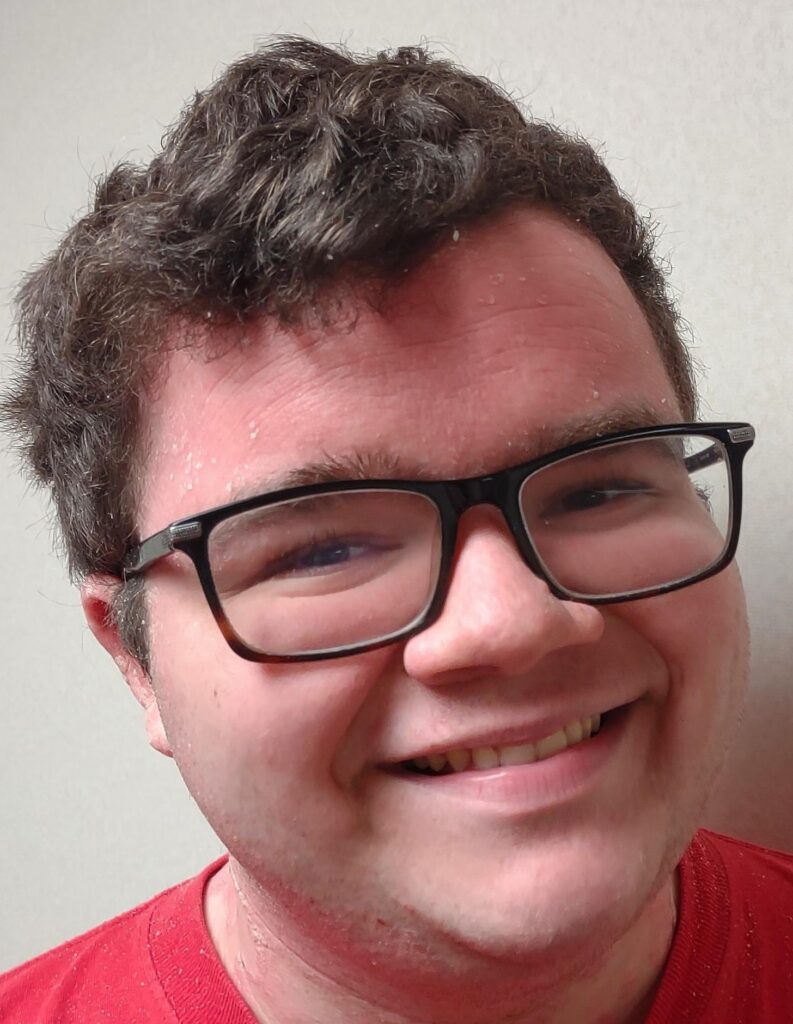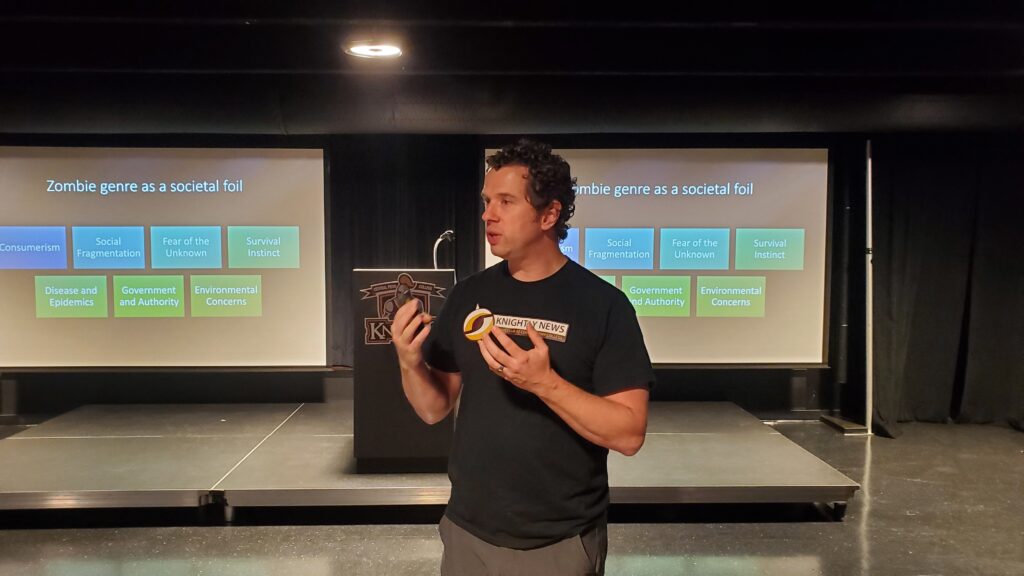Fear and frights highlight fall CPC Film Series
Dr. Jared Rife presents on the 2004 ‘Dawn of the Dead’ just in time for Halloween
Editor’s note: Updated on Jan. 2, 2024, with winter-term film-series information (at end of story).

By Nikolai Hogan
CPC Film Series Correspondent
Nikolai.HadleyHogan@mymail.centralpenn.edu
The CPC Film Series returned to the Capital BlueCross Theatre on Oct. 27 with a showing of the 2004 film “Dawn of the Dead,” a remake of the 1978 flick of the same name. This term’s film series was hosted by Central Penn’s own Dr. Jared Rife. During the event, Rife sat down with the Knightly News to discuss his position at Central Penn, his interest in the film and the zombie subgenre of horror.
Rife has worked for Central Penn College since 2016, where he started as the chair of the humanities department before becoming the program’s dean. He now works as the associate provost and oversees the library and registration office. In addition, he oversees assessment and accreditation for the college and generally works in day-to-day affairs.
The film and what it means
When inquiring about this film directed by Zack Snyder, renowned for the “Justice League” cinematic universe, Rife shared that, in his opinion, it represents Snyder’s finest directorial achievement. He cites how, because it is a reimagining of a classic rather than a direct remake, it gives a great check-in to how the population’s viewing habits have changed since the original film’s 1978 debut and how cultural norms have also changed. While Rife shared that he does enjoy the original films directed by George A. Romero, he mentioned that he was not sure if the older films would captivate the audience as much as the modern retelling would, as many aspects of the original film are outdated and may confuse newer viewers.

The question was posed to Rife about whether the film, blending elements of horror and action, had an impact on his perception of the genres. In response, he affirmed that it indeed had a significant influence. He noted, “It is amazing how flawlessly the film blended horror and action and how modern moviegoers are more attracted to action-oriented films.” He also shared how versatile horror is because it often borrows elements from other genres to make unique experiences consistently, essentially hybridizing genres to create something unique.
Rife said he acknowledges this film as one that put Snyder on the map as a director because it mixed the two genres long before he made “300” or worked with DC Comics. “Dawn of the Dead” was Snyder’s first feature motion picture after spending a significant amount of time directing music videos and other short-form productions. The film has a more action feel but does not escape the horror roots of Romero’s original franchise. Rife prefers the zombie subgenre because it allows directors to take various approaches to how it affects people, which can be a grand scale or a personal story while investigating the psyche of how humans act when massive, world-altering events occur.
During his presentation, he also said that the zombie subgenre is continuously the most creative because the concept of the undead can come from anything. Some stories, like this film, have people come back to life. Others, like the video game “The Last of Us,” use climate change as a subtext for why it happens. Still others use breakout viruses from labs as the reason. This allows for unique storytelling, even though the general concept of the undead remains the same.

The film’s personal impact
Rife discussed the film’s personal significance, explaining the circumstances of how he initially viewed the movie. He was in his undergraduate years when the film was released and he went to a “dollar theater” (as he called it), where films at least six months old would be shown at a more affordable price. That memory cements most of Rife’s enjoyment of the film, aside from the content itself, because it was a great bonding experience for him and his friends at the time.
During his presentation before the show, Rife elaborated on many topics we discussed in our interview. He also highlighted how vast and expansive the zombie subgenre of horror is. It can consist of action comedies like “Zombieland,” fully-fledged horror like the original “Night of the Living Dead,” or satirical comedy like “Shaun of the Dead.” Here, he brought up the many consequences a real-life event like this would cause and the COVID-19 pandemic and its impact on people. While the pandemic was not a zombie apocalypse, it did bring out the true colors in millions of people. It led to hoarding and scalping products like food, toilet paper and entertainment.
Rife said that the appeal of these films is also because we have no idea what we would do. At least with the pandemic, people generally had Wi-Fi, TV and other forms of entertainment. In the case of a world-ending event like these films often display, nobody would be there to watch towers, servers, and anything else that keeps everyone online, leading to an absolute cutoff of civilization. This concept often makes the zombie subgenre horrifying to many, beyond the concept of the undead — pure isolation.
Final thoughts
This film series was very entertaining for me. As someone who does not watch a lot of pure horror movies, I enjoyed my time with the film and was on the edge of my seat. It tackled concepts that I never would have expected to see in a horror film, like how reproduction works after one has been bitten. Does a bite from a zombie guarantee death? Do we get more emotional and primitive when we need to fight for survival? This film did a spectacular job at putting the audience in the seat of the protagonists, and the crowd reactions guaranteed that the film succeeded in that goal.
Because of the time of year, one last question needed to be asked before we finished our interview: “What is your favorite candy?” Rife said that he enjoys Reese’s Peanut Butter Cups but loves candy corn when it comes to these sweet treats. While this is a statement I wholeheartedly agreed with, a nearby Professor Paul Miller did not seem to agree with that answer. Some may find a preference for candy corn more terrifying than the film itself.
The CPC Film Series will return to campus in the winter term on Feb. 2, at 6 p.m., in the Capital BlueCross Theatre, when Professor of Media Studies and media club co-adviser Paul Miller will present the 1993 classic comedy “Groundhog Day.”


